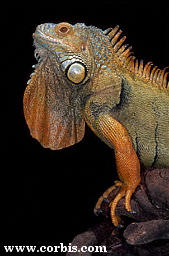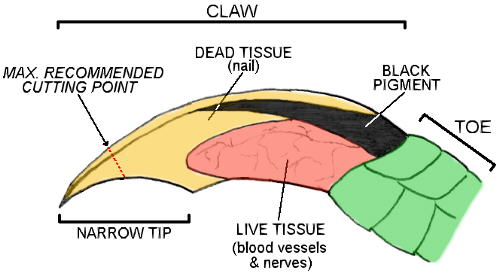
home |
|
cow&chicken page |
|
Iguana info | |
iguana pic`s | |
mp3 archive | |
mp3 players | |
winamp skins | |
sonique skins | |
kjofol skins | |
spawn pic`s | |
witchblade pic`s |

|

|
th person to hit my site!!!

 | ||||||||||
|
Introduction
Anyone who keeps green iguanas (Iguana iguana) cannot fail to be impressed by the way they look. Their dorsal spines, dewlap, tail and long claw-tipped toes all contribute to their unique appearance. In their natural habitat, these physical characteristics play important roles in their social displays, their natural behaviour, and in their camouflage and defence. When we keep one of these demanding reptiles in captivity, however, we need to be aware of what iguanas use these morphological adaptations for, because it will influence the ways in which we house them and care for them. One of the most obvious of these physical adaptations is the presence of the powerful legs, the long toes, and the sharp, curved claws. In the wild, the iguana uses these superbly when walking, running, climbing and leaping. The legs can propel them at surprising speed both along the ground and up trees - something of which you need to be aware if you want to give your iguana a little more freedom. The long toes and sharp claws are used primarily in climbing both up and down branches and trees - they act almost like grappling hooks, or spiked climbing shoes, providing a strong grip on otherwise potentially slippery surfaces. A fall from a great height could result in disaster for an iguana.
Claws in Captivity
What about age? Should small juveniles have their claws trimmed? It�s certainly a good idea to start early - that way you have more chance of getting the iguana used to the routine of claw trimming. More care must be exercised, however. Juveniles have much smaller claws which are less well-defined than those of older iguanas, and it�s easier to make a mistake. In this case, it may be easier to use a smooth file on the claws, as this minimises any risk of injury, and very little actual claw tip needs to be removed. Once they get used to you �messin�� with their claws (which also gives you the opportunity to check for unshed scales or caught fibres), they�re more likely to co-operate when they get larger - and they do get larger very quickly if you're looking after them properly!
Trimming Iguana Claws

The second part of the claw is the sharp, curved tip. The top of the claw grows at a faster rate than the lower part, which is why it curves downwards. The claw tip contains no blood vessels or nerves - it is dead, just like the tips of your fingernails. This is the part of the claw you need to cut. It�s best to use a pair of small dog claw trimmers for this - human nail scissors or clippers are not designed for cylindrical claws like an iguana�s, and tend to crush and damage the claw. But how much do you cut off? It�s a good idea to cut no more than half of the claw tip off (see dotted line on diagram). Not only does this reduce the chance of you making a mistake and cutting into the living part of the claw, but it�s also better for your iguana. If you remove too much, your iguana will have very blunt claws, particularly if you file and smooth the end. While this may seem better for you, with less chance of being scratched, it�s a poor deal for the iguana which uses its claws during climbing and may therefore be unable to move around in its enclosure properly. Blunt claws increase the chance of the iguana slipping, especially on branches, and therefore injuring itself. Cutting off no more than half of the tip will ensure that its claws are still sharp enough to be effective, but not so sharp that it makes handling your iguana a hazardous experience. Iguanas often don�t like having their claws trimmed, although they get used to regular routines - once every two to three weeks if you trim less than half of the claw tip. My iguana has come to accept it as �one of those things� and looks at me as if to say �Go on then, if you really must.� An irregular routine will only be stressful for the animal. If you can, try and get someone else to hold the iguana, preferably in a soft towel, while you do the trimming. Holding the appropriate leg is also a good idea, otherwise sudden movements increase the risk of you making a mistake. If you simply can�t get someone else to help, then there are other solutions, such as trimming claws after the iguana has fallen asleep each night. Don�t try and rush through the job - be slow and methodical, dealing with claws in the same order each time. Once the claw has been trimmed, make sure the end is clean and tidy. Split claws will trap dirt, which may be transferred to your skin if you�re scratched. If you do make a mistake and cut into the living claw, make sure you clean the tip of the claw with a sterile swab. The wound should stop bleeding quickly, but specific products available from your vet can be used to stem the flow of blood more rapidly.
Is Trimming Really Necessary?
Another reason for trimming is to benefit the iguanas. In the wild, iguanas tend to do more climbing, running and leaping over a variety of different surfaces than they do in captivity. This provides plenty of opportunities for the claws to be worn down naturally. Captive iguanas which do not have their claws trimmed can eventually develop problems, whereby claws can become too long and curve back on themselves, even injuring the iguana or others in the same habitat as they climb about. As the iguana�s caretaker, it should be your responsibility to keep your iguana in peak condition, and regular claw trimming should be one of the many ways in which you achieve this. |
